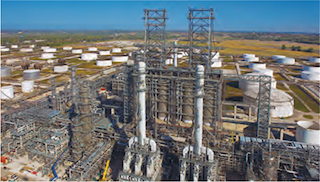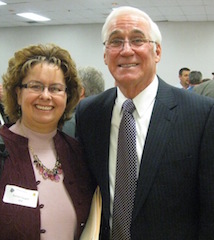Labor-management cooperation works – very well

Metro East area projects prove it
By CARL GREEN
Illinois Correspondent
Collinsville – A new research report says the Metro East area has become the ultimate proof that labor-management cooperation really does work – and that we need more of it.
Six construction projects described in the report, ranging from an elementary school to one of the Midwest’s largest power plants, shared common results that any builder would want:
- On-time completion.
- Costs within or below budget.
- No work stoppages.
- A spirit of pride and cooperation.
- High-quality construction.
- Excellent safety records.
The projects include two of the largest in the Midwest in recent years – the Prairie State Generating Campus, in Washington County, IL, southeast of St. Louis, and the Phillips 66 refinery renovation at Wood River in Madison County, both successfully completed.
All of the projects used Project Labor Agreements (PLA), arranged by the Southwestern Illinois Building & Construction Trades Council, to plan the work, organize the union workforce, control costs and deal successfully with delays and other setbacks.
They frequently used the Tripartite Approach, in which unions, contractors and the property owners join forces in a cooperative venture instead of as adversaries.
“As the case studies certainly demonstrate, each of the six construction projects highlighted in this research provides strong evidence that working collaboratively as a team really is the key to successful construction projects,” conclude the researchers, Ronda Sauget of Webster University and Marvin Finkelstein, a sociologist at Southern Illinois University Edwardsville.
The study was commissioned by the Southwestern Illinois Labor Management Committee, which has worked for more than 30 years to replace the adversarial approach with cooperative efforts using PLA and Tripartite. The group wanted data to help it determine how well its efforts have paid off and how it should proceed in the future.
The committee is part of Leadership Council Southwestern Illinois. Finkelstein is executive director of the committee, and Sauget serves on the Leadership Council board.
GREAT RESULTS

The results strongly support the region’s efforts to build a cooperative approach. Here is how Sauget and Finkelstein stated them in the report:
• Mutual benefits – “All six cases reported highly positive results and mutual benefits from engaging in cooperative labor-management agreements and practices for stakeholder groups – owners, contractors and labor.”
• Cost savings – “There was no evidence to suggest that PLAs contribute to higher costs and reduced competition. To the contrary, successful PLAs tend to produce both short-term and long-term cost savings. All six projects were completed on time and within the project budgets.”
• Productivity, quality, safety – “The use of PLAs and related Tripartite arrangements resulted in significant cost savings, improved quality, greater productivity and higher levels of safety.”
• Problem-solving – “Cooperative agreements such as PLAs and the Tripartite model can increase communication, trust, respect and collaboration among all parties, and encourage swift problem-solving, innovation and flexibility.”
• Labor cooperation – “Positive results may be attributed to an informed and committed labor-management leadership who were able to successfully resist an adversarial past, to learn, create and maintain strong cooperative relationships.”
• The future – “Future success of the construction industry in Southwestern Illinois may well hinge on workforce and leadership awareness of cooperative and collaboration agreements and practices. Without increasing workforce and leadership education, training and support, there is a strong likelihood that these efforts will fail.”
The just-issued case studies describe each project and include commentary from the contractors, the property owners and from Dale Stewart, who, as executive secretary-treasurer of the Building Trades Council, represents the union workforce in the PLA and Tripartite work.
The case studies also show how contractors and workers were able to adjust to changing project conditions, such as when engineering delays and late machine deliveries threatened to wreck a tight schedule on a Granite City industrial building. Cooperation between the contractor and workers made up the lost time and allowed the job to be finished on schedule and on budget.
PRAIRIE STATE GENERATING COMPANY

This large generating station, equipped with its own coal mine, was completed in 2012 by Bechtel Corp. and now supplies eight non-profit utilities serving 2.5 million families in eight states. It cost more than $4 billion and employed 4,000 skilled workers with more than 24 million man-hours.
The authors interviewed Prairie State’s corporate director of industrial relations, Michael Rother, who said the company needed some certainty going into the project because of its immense scope.
“To date, over five years later, our selection of the union crafts has proven to be, without a doubt, a complete success story, and every craft worker involved should be proud to have their footprint of success on our historic and celebrated project,” Rother said.
WORKERS EMPOWERED
Workers were empowered to implement a “zero accident performance” goal and at one point went 5.3 million man-hours without a lost time incident.

“You could see the growing pride in what we were doing here,” Rother said. “The union professionals had a sense of ownership, wore PSGC hats and T-shirts, implying, ‘We were part of this historic project and proud of it.’”
The Plumbers and Pipefitters worked with the contractor to develop a 16-week welding school on-site to help workers meet quality standards for complicated welds. At one point, they made more than 35,000 pipe welds with an extremely low reject rate of less than 2 percent.
The Boilermakers were welding, too, completing 70,000 welds on the two high-capacity boilers without a single leak in field tests.
“We are extremely proud of how well our welding trades performed on this project,” Stewart said. “Pre-planning and working collaboratively is the key to having a successful construction project.”
The Ironworkers, following their Standards of Excellence, installed more than 30,000 tons of boiler steel early in the project, allowing the other crafts to get on with their parts in the project.
Sauget and Finkelstein summed it up this way:
“The Prairie State Energy Campus demonstrates what can be done when labor and management collaborate and communicate effectively,” they wrote. “The results can be seen in the time and cost savings, and the quality and the outstanding levels of safety achieved in this immense project.”
PHILLIPS REFINERY
Phillips 66 wanted to renovate its Wood River Refinery to be able to process more heavy Canadian crude oil, so it planned the $3.8 billion Coker and Refinery Expansion Project, which affected almost every part of the giant refinery. Main construction went from 2008 to 2011.
The report compares the job with five other such “mega projects” carried out in the industry at the time, and finds it to have been the safest, the second fastest in completion and the best at avoiding cost increases.
Four contractors worked with 4,600 construction workers at the various sites, which required enormous organizational efforts, materials management and inventory control.
“Using the Tripartite approach, monthly job progress meetings provided the foundation for a good work environment with a high level of cooperation from all parties,” the report states.
Larry Sicking, senior project manager for Phillips, told the authors how important those meetings, and others, turned out to be.
“We learned quickly how impactful meetings were, using a true tripartite approach, to the overall success of our project,” he said. “We openly discussed real problems and proactively solved those problems without blaming each other.”
Dale Stewart represented labor at the monthly meetings.
“There was a strong emphasis on safety from the beginning of this project, with everyone looking out for each other,” he said. “If any concerns existed, we openly discussed them, and the issues were promptly addresses.
“For a project of this size, I am so proud of how everyone worked together and communicated openly.”
ABENGOA ETHANOL PLANT
The Spanish firm Abengoa hired Alberici Constructors to build a $74 million ethanol plant at America’s Central Point in Granite City, completed in 2009 and capable of making 88 million gallons a year of the plant-based fuel.
Alberici wanted to try some new building techniques to reduce the cost and environmental footprint, so it met with Stewart early in the process to get its labor plans in place.
“With several other large projects under construction at the same time, we worked very closely with Alberici to ensure all aspects of the project were maintained at the high levels, such as safety standards and quality workforce,” Stewart says in the report.
“We made sure any concerns were addressed and resolved immediately, enabling the project to be completed on time and within budget.”
The project that could have fallen behind schedule because of changes ordered by Abengoa, engineering delays and late equipment deliveries. The trade unions, however, agreed to work 10-hour days and six-day weeks to stay on schedule. At times, 650 worked by day and another 150 worked at night. The project was finished on time, and with a good safety and quality record.
LeRoy Stromberg, an Alberici executive, credited the union workers and their level of training.
“The trades bring a level of performance consistency and quality of work that helps us to achieve our project goals,” he said. “We work all over the country and struggle to find the quality of people we see here in our regional area. It would be great if all construction trades were trained to this level with this type of performance across the U.S.”
EDWARDSVILLE SCHOOLS
Twenty years ago, this large school district known for its high achievement needed to build a new high school and make other building improvements, but the new superintendent, Ed Hightower, found a lack of consensus and support in the community.
The district began working to meet with community members to build new relationships. Then, facing a $16 million renovation project for existing schools that had to be done before the new construction, it entered into a Project Labor Agreement with the Building Trades Council.
The PLA allowed the community to deal with issues such as disagreements between trades and concerns about workforce diversity. The report states: “These were difficult moments, but unlike in the past, there was a framework in place to deal with them.”
Following that positive experience, the district was able to pass a bond issue that paid for two much-needed new elementary schools, renovations to existing buildings and the new high school, totaling $68 million in all. Volunteers including union members stepped forward to handle some smaller projects. Hightower and Stewart worked so closely together that no outside project managers were needed, the report says.
“Just a few years earlier, few people could have imagined that such things were possible,” Hightower said. “It appears as if the Edwardsville school district built more than new buildings.”
Stewart said building trust and collaboration as a team made the difference.
“It was clear from the start that open communication and working through tough issues would create a sense of community faith in the projects and overall pride that everyone was working to make the right decisions for the school district and children,” he said.
SIUE SUCCESS CENTER
This $11 million, 68,000 square-foot addition to the Morris University Center was built in 2008-09 to consolidate student service offices. It used some recycled products and also green roof blocks, where plants now grow.
The project was on a tight time frame to be ready by the beginning of school, but a series of delays, including change orders and bad weather, threatened to wreck the schedule.
Lead contractor Bruce Unterbrink Construction extended the timeline by 30 days and worked closely with the Building Trades Council under PLAs to literally make up for lost time.
“Everyone pitched in, added extra workers and worked overtime to complete this project on time and with great quality in workmanship,” Unterbrink told the researchers. “This is something to be proud of.”
WASHINGTON COUNTY K-12 SCHOOL
West Washington County School District decided in 2010 to completely rebuild itself, starting with a multi-purpose building for junior and senior high schools, plus a gym, cafeteria, kitchen and district offices.
A second phase added rooms for kindergarten through 6th grade with art and music rooms, a computer lab and a community library, while the old building was demolished. Altogether, it was a $29 million project.
Holland Construction Services and FGM architects held community meetings to explain the one-building concept and build support. Stewart met with the school board to explain the PLA process.
“Having a PLA on this project ensured that efforts would be made to increase communication, sharing information among all stakeholders, and a smooth running project across all aspects, including stakeholders participating in planning, design and construction,” Stewart told the researchers.
Over 30 months of construction, about 100 workers, eight union locals and 29 contractors coordinated their efforts. Frequent meetings helped keep the project moving forward.
“These meetings helped to create ongoing lines of communication and to address unanticipated problems as they emerged,” said Jim Niemeyer, field site superintendent for Holland.
Some work had to be done while school was in session. An unanticipated asbestos removal was required. The weather could have been better, too.
Niemeyer said he noted increased unity among the trades. “The project was completed in April 2013, and came in on time and on budget with a zero accident rate,” he said. “By all accounts, though there was a tight schedule to ensure a smooth transition into the school year, the project was a resounding success.”


Leave a Reply